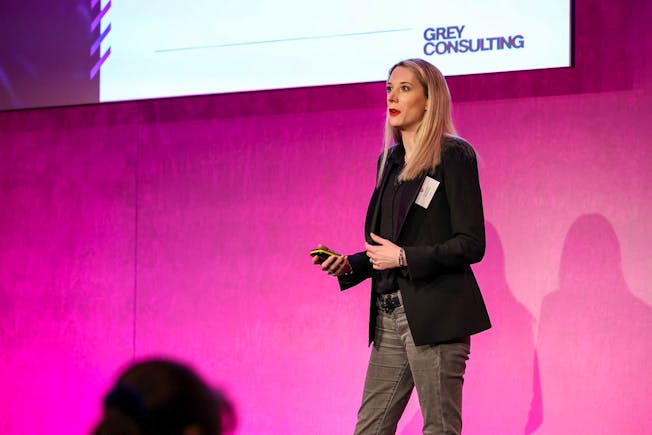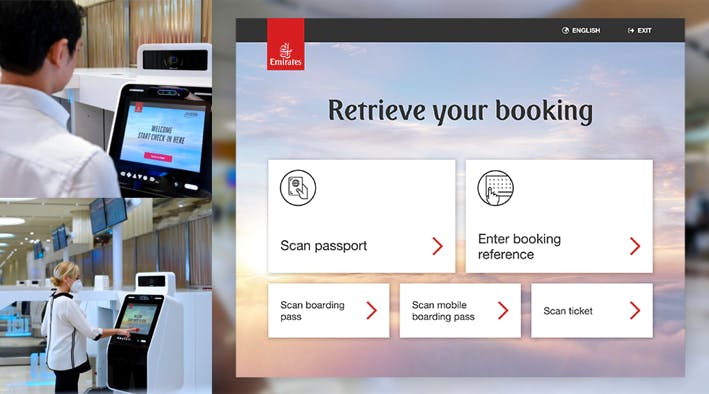
“But when we think about employees within that context of culture, i.e., the job of the employees, we think about them in terms of ‘how do they facilitate that customer experience’ – it’s all in service to the customer.”
According to Lindemann, most organisations think about CX in terms of a ‘classic service blueprint.’
“So really, rather than looking at the solution for ‘how do we fix people’, [it’s about] looking at – rather than top-down transformation – identifying those root causes and driving change from the bottom by removing one blocker at a time.”
Katy Lindemann, Principal Consultant for Grey Consulting, told attendees at ‘Econsultancy Live: CX 2022‘ that CX failure tends to be due to “organisational inertia.”
Lindemann emphasises the fact that more engaged employees can deliver more valuable experiences for customers. However, EX isn’t a silver bullet.
Driving customer-centricity: “Employees as main actors rather than the supporting cast”
“When we’re thinking about transformation, what makes up the reasons why it fails? Very often the moments that matter are often day-to-day and sometimes even hour-to-hour, and ultimately, smaller everyday behaviours ladder up to bigger cultural challenges.”
Again, Lindemann said that it boils down to culture – and the shared beliefs, values, and practices – that are impeding CX innovation and transformation efforts. What’s more, she said it’s actually about ‘sweating the small stuff’.
“Essentially, if we’re saying most transformations fail because we don’t consider people, and now we’ve got a process or a discipline [for people] – is that going to be the answer? Yes and no,” she concluded.
“So, [now], I’m thinking about the employee, your people, as actors in [the movie] rather than just the supporting cast.”
Ultimately, it turned out that the root issue was employee confidence. “It was the fact that so much of the way that things had been rolled out [such as training]… was so daunting that it was incredibly difficult to navigate,” she explained.
“Culture very often isn’t considered from the start,” she said, “but those who do consider it from the start are five times more likely to actually achieve positive results.”
Lindemann says that this approach is fine, but ultimately, it forgets the ‘people’ element.
The EX opportunity: “Culture isn’t a monolithic thing”
DBS went on to create ‘Meeting MoJo’ – and implemented both a ‘Meeting Owner’ and a ‘Joyful Observer’ for every meeting to encourage collaboration and foster more productive outcomes. The MoJo strategy was so successful that DBS went on to turn it into an app, enabling other companies to use it, too.
We often hear about companies investing in CX transformation. But post-investment, what are the factors that actually make or break transformation? After all, research suggests that only 30% of big digital transformation projects typically achieve their target objectives and create sustainable change.
“…technology itself isn’t a solution. And I think this is the hardest part of an organisation to change.”
Interestingly, Lindemann suggests that the past couple of years has seen a shift in the way companies think about employee’s needs (largely driven by the ‘great resignation’), towards a more inclusive approach.
Lindemann cited one unnamed example of a large brand that did all the legwork for CX transformation – the training, the upskilling, and building the centres of excellence – and yet nothing changed.
“It’s all about, essentially, putting the people first. So, whereas the goal of CX improvement is to get that customer loyal to a brand and to buy more and recommend that brand, with EX it’s how can we get the people that work for you to bring their best selves to work, and give their attention so that they can really work to the best of their ability?”
“That [service] is for the benefit of the employer,” she says. “If you don’t feel valued and you don’t feel that you have a relationship… you know that it is much less likely to deliver positive results.”
Lindemann also mentioned DBS Bank, a well-known case study of how sweating the small stuff can help transform a business. Despite a strong company culture and vision, DBS identified a particular productivity issue.
Facilitating change: “Identifying root causes and removing one blocker at time”
She goes on to explain that rather than the employee being the sole responsibility of HR, the approach to EX should be a mirror of the way that companies approach thinking about the customer.
Lindemann said that this is a great example of how to avoid overlooking what really matters. “Ultimately, on the one hand, you’ve got a vision of saying ‘we want to be agile, we want to deliver this transformation’, but it comes down to something that – when you’re looking at an employee experience… [the idea of] meetings isn’t necessarily going to come up.”
“Culture isn’t a monolithic thing. It’s lots of interactions. And so actually thinking about trying to solve an overarching lifecycle is a great thing to do, but it may not necessarily pick up the kinds of things that are actually the challenge.”
“That’s why I come back to saying looking at your culture and trying to diagnose the problem,” she concluded.
“So, when we ask ‘what do we mean by culture’? It really is about the small stuff. If we can just think about the seed and the soil… that’s where I think we can succeed.”
“When we think about culture, it is invariably thinking about…how do we embed a customer-centric culture? How do we drive a company that is customer obsessed? What are the ways of working that we can embed – whether it be re-organising teams or going down on the shop floor – any different ways to get closer to the customer.”
“So, if we know that transformations generally often fail because we’re not thinking about people, and EX is a discipline that we’re starting to think about, how do we get closer [to transformation]?” asks Lindemann.
Lindemann suggests that within the fundamentals of CX transformation, people are often considered last, and the concept of ‘culture’ lags even further behind that.
“…they were spending an inordinate amount of time in unproductive meetings, and what that meant was it was creating additional layers of complexity. So, all of their great ambition to be agile and to be customer-obsessed, was being completely undone by completely unproductive meetings which would then derail things.”






